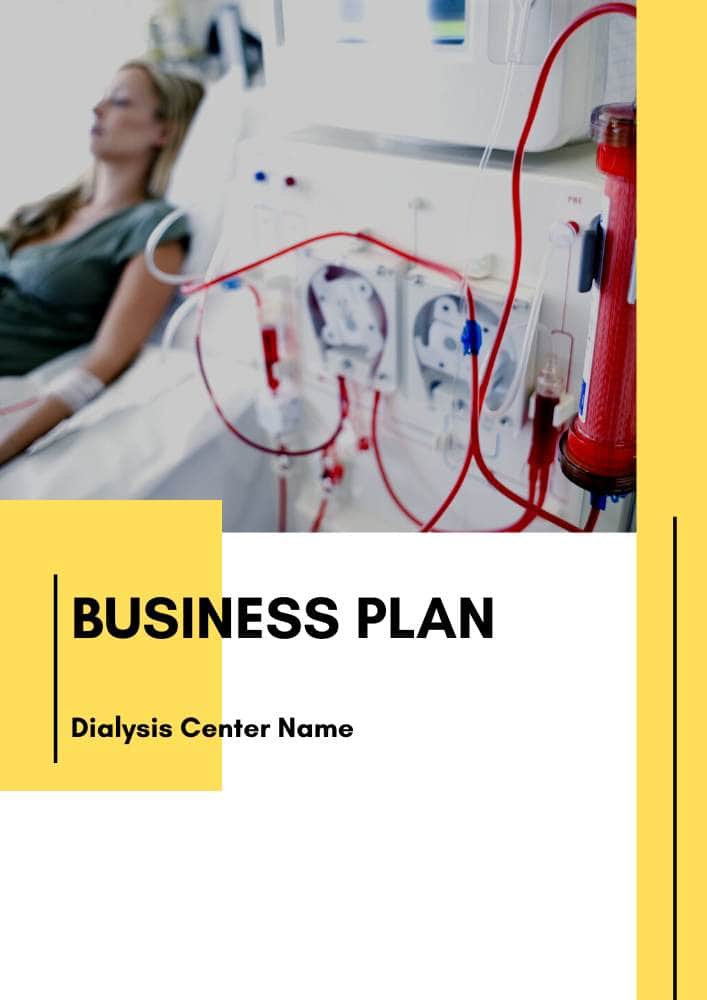Written by Elma Steven | Updated on January, 2025

How to Write a Dialysis Center Business Plan?
Dialysis Center Business Plan is an outline of your overall dialysis center business. The dialysis center business plan should include a 5 year financial projection, marketing plan, industry analysis, organizational overview, operational overview and finally an executive summary. Remember to write your executive summary at the end as it is considered as a snapshot of the overall business plan. You need to be careful while writing the dialysis center business plan as you need to consider various factors that can impact the business’s success. Read the sample dialysis center business plan in order to have a clear understanding of the process.
Table of Contents
Executive Summary
Miami Renal Oasis is a premier dialysis clinic that provides first-rate service to those dealing with kidney-related illnesses. Our clinic provides complete dialysis treatments in a calm and encouraging setting and it was founded by Sofia Rodriguez. She is a seasoned healthcare provider with a passion for changing the face of renal care.
Mission: Our mission is to provide exceptional dialysis care that empowers our patients to lead fulfilling lives. We aim to deliver personalized treatment plans, compassionate support and innovative solutions to improve the well-being of those affected by kidney diseases.
Vision: Our center strives to set new benchmarks in renal care through continual innovation, patient-focused approaches and a dedication to improving lives within the Miami community and beyond.
Industry Overview:
There is a rapidly expanding population in the United States impacted by kidney-related illnesses making the dialysis treatment business an essential part of the healthcare system (gminsights). An anticipated valuation of $200 billion in 2023 indicates a sizable market (fortunebusinessinsights). Throughout the next few years, analysts predict a constant CAGR of 60% (market).
Financial Highlights
Break- Even Analysis

Investments or Fund Usage Plan

Business Description
Business Name: Miami Renal Oasis
Founder: Sofia Rodriguez
Management Team:

Legal Structure: LLC
Location: Miami
Goals:
✔️ Market Leadership: In order to achieve a 15% gain in market share during the next 12 months the dialysis facility will use concentrated marketing methods such as community health initiatives and incentives centered around patients. Joining up with other healthcare organizations and taking part in health-related events are two ways to increase exposure for your brand and attract new patients.
✔️ Customer Satisfaction: Knowing how critical it is to provide excellent customer service the laundromat will train all staff members thoroughly. Improving communication with consumers is key to our plan to increase their happiness by 25%. Part of this effort is a dedication to training, feedback mechanisms and solving customer concerns effectively and quickly.
✔️ Operational Efficiency: Our goal in enhancing client interactions is to achieve a 25% increase in customer satisfaction ratings. In this endeavor is a commitment to promptly and effectively resolving customer issues, frequent training sessions and feedback mechanisms.
✔️ Brand Recognition: Reach a 25% increase in brand exposure during the next quarter by expanding the reach of promotional activities via social media, engaging in local events and developing partnerships.
✔️ Expansion and Growth: The following six months the laundry will launch a feasibility study to investigate potential additional locations in high-demand areas in an effort to expand their company.
Services:
✔️ At-Home Dialysis Service: Offer a convenient at-home dialysis option for patients with busy schedules or limited mobility. This service provides essential treatment in the comfort of the patient’s home ensuring continuity of care and convenience.
✔️ Specialized Dialysis Care: Expand the range of services to include specialized dialysis treatments, catering to patients with specific medical needs. This could include hemodialysis, peritoneal dialysis and other advanced treatment options for various kidney conditions.
✔️ Online Appointment Booking and Management: Facilitate easy scheduling and management of dialysis sessions through a mobile app and online system. This technological integration demonstrates the center’s commitment to modern, efficient healthcare delivery, enhancing patient convenience and experience.
✔️ Membership Programs: Introduce membership programs for regular patients, offering benefits like priority scheduling or discounted rates for additional health services. This approach fosters patient loyalty and provides a stable revenue base for the center.
✔️ Specialized Kidney Health Services: Offer additional kidney health services such as nutritional counseling and support groups for dialysis patients. These services address the broader needs of patients with kidney issues providing comprehensive care beyond standard dialysis treatment.
Business Model Canvas
The Business Model Canvas is a high-level overview of the business model. It can also be considered as the business model map in the overall dialysis center business plan. A company idea’s complexities may be mapped out, analyzed and communicated with the use of the canvas. It shows the whole picture of a company’s value creation, delivery and identify processes. It helps new business owners hone their ideas, encourage creative thinking and make sound strategic decisions. Business Model Canvas is a helpful resource for coming up with ideas, organizing plans and presenting business models to key players.
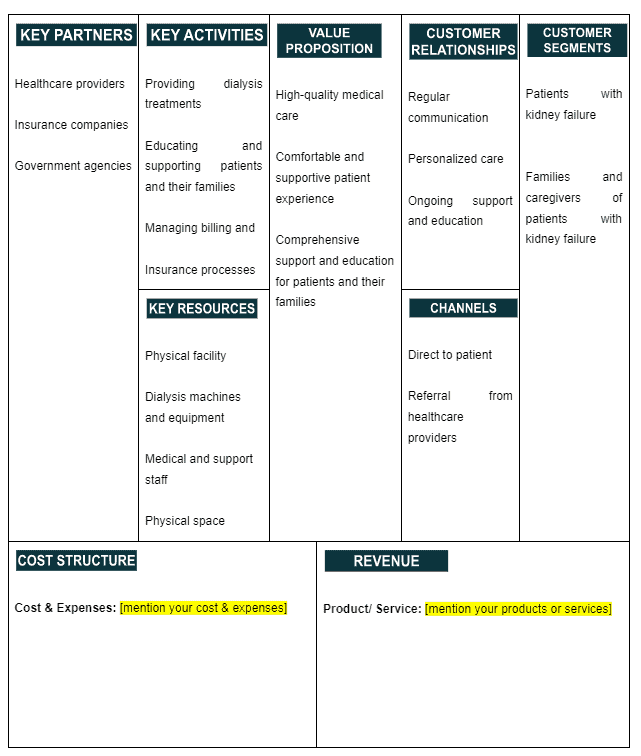
SWOT
Your dialysis center business plan should include a thorough SWOT analysis. It’s a method for figuring out how to deal with obstacles and finding the best paths to follow. “SWOT” stands for strengths, weaknesses, opportunities and threats. Before deciding on a course of action whether it be exploring new projects, overhauling internal policies, assessing possibilities to pivot or making adjustments to a plan halfway through implementation a thorough SWOT analysis should be conducted.
Here is a sample SWOT analysis for your dialysis center business plan:
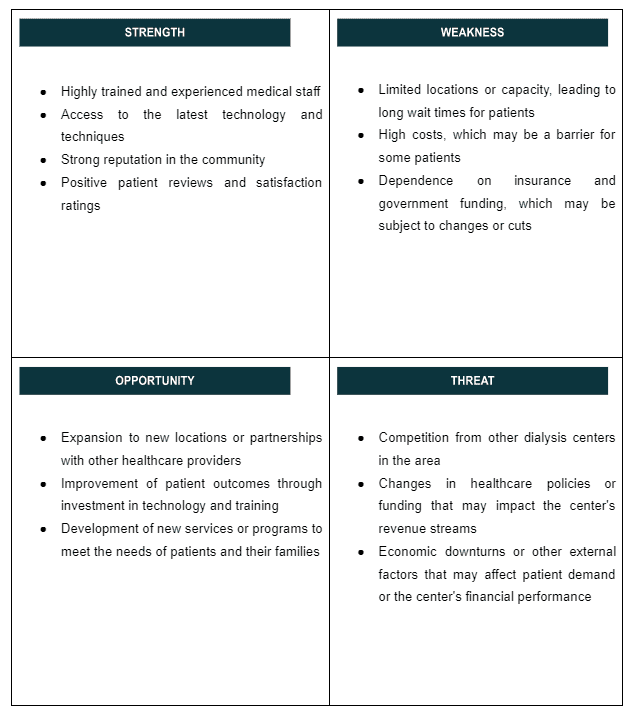
Marketing Plan
Promotional Channels
Online Presence – $12,000 (30%)
✔️Website Enhancement: Ensure a user-friendly, informative website detailing services, staff expertise, patient testimonials, educational resources about kidney health and dialysis options.
✔️Content Creation: Regularly publish blog posts or articles covering topics such as kidney disease management, dialysis techniques, dietary recommendations and patient success stories.
✔️SEO Strategy: Optimize website content for relevant keywords related to kidney health, dialysis treatment and local health services to improve search engine rankings and attract organic traffic.
Social Media Engagement – $8,000 (20%)
✔️Platform Selection: Focus efforts on platforms like Facebook, Twitter, LinkedIn, sharing informative content, patient stories and awareness campaigns.
✔️Visual and Written Content: Share educational infographics, videos explaining dialysis procedures, patient experiences and healthcare tips for kidney disease management.
✔️Community Engagement: Engage with online communities related to kidney health, participate in discussions and offer helpful advice and support.
Educational Outreach – $7,000 (17.5%)
✔️Seminars/Webinars: Host or sponsor educational events, seminars or webinars about kidney health, disease prevention and dialysis options.
✔️Partnerships with Healthcare Providers: Collaborate with local physicians, clinics, hospitals for referral programs or joint awareness campaigns.
Patient Support Initiatives – $6,000 (15%)
✔️Support Groups: Establish or sponsor support groups for dialysis patients and their families providing a platform for sharing experiences and offering emotional support.
✔️Educational Materials: Develop printed materials, brochures or e-books explaining the dialysis process, lifestyle adjustments and managing kidney disease.
Local Community Engagement – $5,000 (12.5%)
✔️Health Fairs and Events: Participate, sponsor local health fairs, community events, senior centers, offering free health screenings or educational sessions.
✔️Collaboration with NGOs: Partner with non-profits focused on kidney health or community health awareness supporting their initiatives and gaining visibility.
Referral Program and Patient Retention – $2,000 (5%)
✔️Referral Program: Create incentives for existing patients to refer new patients, offering discounts or additional services for successful referrals.
✔️Patient Appreciation Events: Host events or initiatives to show appreciation to existing patients, fostering a sense of community and loyalty.
Brand Management
Brand Voice and Visual Identity – $10,000 (25%)
✔️Brand Messaging: Develop a compassionate and informative brand voice that conveys expertise, care and support for patients dealing with kidney health issues.
✔️Visual Identity: Maintain a consistent visual style across platforms, featuring the center’s facilities, medical staff, patient care and positive patient outcomes.
User-Generated Content – $6,000 (15%)
✔️Patient Testimonials: Encourage satisfied patients to share their stories and experiences. Share these testimonials across social media platforms and the website to build credibility and trust.
✔️Community Engagement: Share educational content, patient testimonials and relevant health tips to engage with patients, caregivers and the broader community.
Educational Content Creation – $8,000 (20%)
✔️Blog and Video Content: Produce informative articles, videos and infographics covering topics such as kidney health, dialysis procedures, treatment options, dietary recommendations and patient stories.
✔️Webinars and Seminars: Host online webinars or in-person seminars providing information about kidney health, disease management and dialysis treatment options.
Search Engine Marketing (SEM) and Local SEO – $7,000 (17.5%)
✔️Ad Campaigns: Run targeted ads highlighting the center’s specialized dialysis services, expert staff, patient-centered care and the latest technology in kidney treatment.
✔️Website Optimization: Ensure the website is visually appealing, informative and optimized with relevant keywords like “dialysis center,” “kidney treatment” and “renal care” to improve search rankings.
✔️Google My Business: Maintain an updated Google My Business profile with accurate information, photos and services offered to enhance local search visibility.
Community Engagement and Partnerships – $4,000 (10%)
✔️Local Health Events: Participate, sponsor health fairs, community events or senior centers offering free health screenings, educational sessions and information about kidney health.
✔️Partnerships with Healthcare Providers: Collaborate with local physicians, clinics, hospitals for referral programs and joint awareness campaigns focusing on kidney health.
Referral Program and Patient Retention – $5,000 (12.5%)
✔️Referral Incentives: Create a referral program offering discounts or additional services for existing patients who refer new patients to the dialysis center.
✔️Patient Appreciation Initiatives: Organize events or programs to show appreciation to existing patients fostering a sense of community and encouraging patient retention.
Go To Market Strategy
Online Presence and Community Engagement
✔️Professional Website: Launch a user-friendly website highlighting the center’s facilities, treatment options, patient testimonials and educational resources about kidney health.
✔️Content Marketing: Regularly publish informative blog posts, articles, videos about kidney health, treatment procedures, dietary recommendations, patient stories and medical advancements in the field of nephrology.
✔️Local Directory Listings: Ensure the center is listed on relevant online healthcare directories and local business listings to enhance visibility.
✔️Partnerships: Collaborate with local healthcare providers, community centers, patient advocacy groups to offer educational seminars, health screenings and support programs for kidney health awareness.
Center Launch Event and Promotional Offers
✔️Launch Event: Organize an open house or launch event inviting healthcare professionals, patients, caregivers and community members to tour the facility and learn about the center’s services.
✔️Introductory Offers: Provide introductory discounts or package deals for new patients to encourage initial engagement with the center’s services.
Digital Marketing and Customer Relations
✔️Social Media Engagement: Utilize platforms like Facebook, Twitter, LinkedIn to share informative content, patient success stories and health tips, fostering engagement and trust within the community.
✔️Email Marketing: Implement an email newsletter strategy to communicate updates, health tips, success stories, special offers, keeping patients and stakeholders engaged.
✔️Loyalty Program: Create a loyalty program to reward returning patients with discounts or additional services to encourage continued engagement.
Brand Awareness and Public Relations
✔️Local Media Outreach: Engage with local media outlets for interviews, articles or features to increase brand visibility and educate the community about kidney health.
✔️Community Involvement: Participate in health fairs, community events, support groups to actively engage with the community and offer valuable information about kidney health.
✔️Healthcare Partnerships: Collaborate with local healthcare providers, clinics, hospitals to establish referral programs and joint awareness campaigns focused on kidney health.
Performance Tracking
✔️Analytics and Feedback: Regularly analyze website traffic, social media engagement metrics, patient feedback to assess the effectiveness of marketing efforts and services offered.
✔️Adaptation: Remain flexible and adaptable, making necessary adjustments based on insights from analytics, feedback to continually improve services and marketing strategies.
Organizational Overview
Information related to your company’s structure and management team should be summarized in the Organizational Overview section of the dialysis center business plan. It’s especially important to include this section if you have a partnership or a multi-member limited liability corporation (LLC). You should explain about the functions of key roles in your dialysis center business. In addition, explain how the founder along with top management team’s past experiences and credentials can create a successful dialysis center business
Founder

Sophia Rodriguez exemplifies the power of combining one’s own values with one’s professional training to establish a “RenewLife Dialysis Center” a remarkable healthcare institution. A lifelong goal of Sophia’s was to help others suffering from renal illness which led her to pursue a career in medicine. She was compelled to make a positive impact in the renal health area after seeing close relatives deal with similar issues.
Sophia has extensive knowledge of patient care especially in relation to long-term conditions like renal disease thanks to her education and work experience in healthcare administration. She is very skilled in both the medical aspects of dialysis therapy and the art of making the healthcare system more patient-centered.
Located in a place that desperately needs high-quality kidney care where Sophia’s business endeavor the “RenewLife Dialysis Center” exemplifies her dedication to affordable and caring medical treatment. In addition to medical treatment patients here get holistic care that takes into account their mental, emotional and spiritual health.
A safe and enjoyable treatment experience is guaranteed by the center’s latest dialysis equipment and its cozy surroundings. Because Sophia and her staff value tailored attention they tailor treatment programs to each patient’s unique set of symptoms, medical history and lifestyle factors.
Positions and Responsibilities
Chief Executive Officer (CEO) – Sophia Rodriguez: Sophia is in charge of the dialysis center’s long-term goals and strategies in her role as CEO. She makes sure everything runs well acts as a spokesperson for the center in the business and medical sectors and checks that everything is done according to healthcare rules and laws.
Medical Director: This role involves overseeing the medical aspects of the dialysis center ensuring that patient care meets the highest standards. The Medical Director is responsible for clinical protocols, patient treatment plans and medical team oversight.
Nursing Manager: The Nursing Manager supervises the nursing staff, ensuring that patient care is delivered effectively and compassionately. They also handle scheduling, staff training and oversee the implementation of healthcare protocols.
Dialysis Technicians: Dialysis Technicians are crucial for the technical operations of the center. They operate dialysis machines, prepare patients for treatment and ensure the technical aspects of the treatment are performed accurately.
Patient Care Coordinator: This role involves managing patient relations, handling inquiries, scheduling and providing administrative support. They ensure a seamless experience for patients from initial contact through ongoing treatment.
Organogram
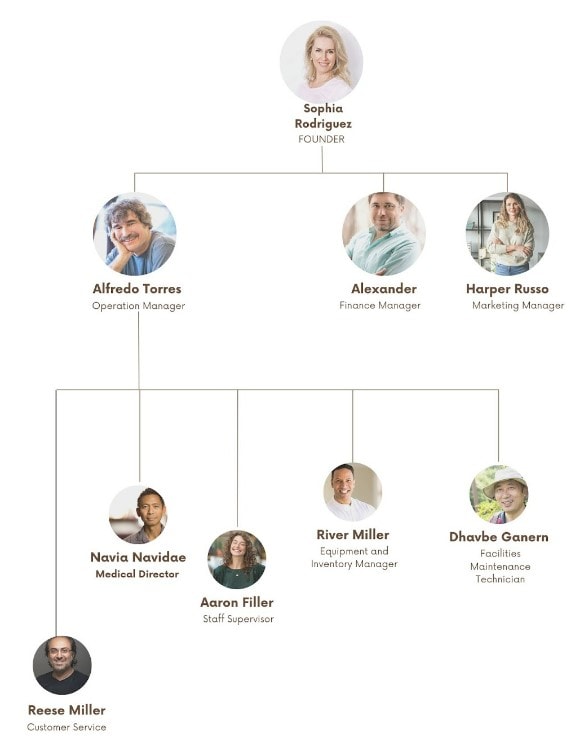
Operational Overview
✔️ Dialysis Services at the Center: Our center offers comprehensive dialysis treatments catering to individuals with kidney conditions. State-of-the-art dialysis machines ensure effective and comfortable sessions suitable for various patient needs.
✔️ Specialized Kidney Care Services: We offer specialist services such as peritoneal dialysis and home dialysis training. This is to make sure that patients have a range of alternatives that satisfy their specific healthcare requirements.
✔️ Flexible Treatment Options: Patients can choose in-center dialysis with our advanced machines or opt for home dialysis training for a more independent approach to their treatment.
✔️ Patient Membership and Support Programs: Our patients benefit from supportive care programs which may include nutritional counseling, psychological support, educational resources creating a sense of community and ongoing support for their health journey.
✔️ Eco-Friendly Healthcare Practices: The center is committed to sustainable healthcare practices including energy-efficient medical equipment and eco-conscious waste management aligning with the growing demand for environmentally responsible healthcare solutions.
Industry Analysis
Overview
It is projected that the worldwide dialysis sector would reach a significant market worth by 2027 (verifiedmarketresearch) thanks to its rapid expansion. Worldwide, chronic renal disease, diabetes are on the rise, both are important causes of kidney failure and the need for dialysis, the main drivers of this expansion. Dialysis has also expanded its patient population because to technological developments that make the therapy more efficient and less invasive. There is a strong correlation between the aging world population and this growth as the former is more likely to have renal problems.

Certain trends seen in specialized service sectors are reflected in the dialysis center industry especially in healthcare. In nations like the US and parts of Europe where kidney illness is common as well as in places like Asia where people are living longer and hence developing more serious renal ailments that need dialysis this industry plays an essential role.
Large healthcare providers and smaller independently owned institutions make up the majority of the sector. Although major hospital networks may have greater resources and a wider reach independent institutions often provide more individualized treatment. Providing cutting-edge dialysis treatments comes with a hefty price tag and staying abreast of new medical developments is only one of the many obstacles this industry must overcome.
Many dialysis clinics are using new patient care and management strategies to tackle these difficulties. Among these measures are the following: the provision of home dialysis training and assistance, the use of sophisticated dialysis equipment to improve patient outcomes, the incorporation of digital technologies to streamline patient care and record-keeping. Dialysis patients are increasingly being encouraged to make dietary and lifestyle changes as part of their treatment plan and there is an increasing emphasis on patient education and holistic care.

Industry Problems
✔️ High costs: Dialysis is a very expensive treatment and the cost of providing dialysis services is continuing to rise. This can be a major burden for patients and their families and it can also make it difficult for dialysis centers to stay afloat financially.
✔️ Shortage of qualified staff: There is a shortage of qualified nephrologists and dialysis technicians which can make it difficult for dialysis centers to provide adequate care to their patients.
✔️ Poor patient outcomes: The increasing cost of dialysis patient outcomes have not improved significantly in recent years. This is due in part to the fact that many patients with ESRD have other health conditions that make it difficult to tolerate dialysis treatment.
✔️ Regulation: The dialysis industry is regulated by the government which can make it difficult for dialysis centers to innovate and improve their services. The regulations are designed to protect patient safety but they can also be costly for dialysis centers.
✔️ Reimbursement: Dialysis centers are reimbursed by Medicare and other insurance providers for the services they provide. The reimbursement rates are often lower than the cost of providing care which can make it difficult for dialysis centers to stay profitable.

Industry Opportunities
✔️ Expanding access to care: Dialysis centers can expand their access to care by opening new locations in underserved areas and by offering extended hours and tele-health services.
I✔️Improving patient outcomes: Dialysis centers can improve patient outcomes by investing in new technologies and treatments such as home dialysis and peritoneal dialysis. They can focus on providing more holistic care that addresses the patient’s overall health and well-being.
✔️ Reducing costs: Dialysis centers can reduce costs by streamlining their operations and adopting new technologies. They can also partner with other healthcare providers to share resources and reduce overhead costs.
I✔️Investing in preventive care: Dialysis centers can help to prevent ESRD by investing in preventive care programs. These programs can help to identify people who are at risk of developing ESRD and provide them with early intervention and education.
✔️ Expanding into new markets: Dialysis centers can expand into new markets by offering new services such as transplant coordination and palliative care. They can also target new patient populations such as the elderly and people with diabetes.

Target Market Segmentation
Demographic Segmentation
✔️ Age Groups: Tailor dialysis care and support services to different age groups, providing pediatric care for younger patients and specialized care for older adults.
✔️ Income Levels: Offer a range of payment options and support for varying income levels including assistance with insurance and payment plans.
✔️ Cultural Diversity: Address the diverse needs of New York’s multicultural population with multilingual staff and culturally sensitive care practices.
Psychographic Segmentation
✔️ Convenience Seekers: Provide efficient and flexible dialysis scheduling options for patients who prioritize convenience and time management.
✔️ Health-Conscious Individuals: Cater to patients who are proactive about their health with comprehensive wellness programs and educational resources.
Behavioral Segmentation
✔️Regular Patients: Develop loyalty and continuity programs to support and encourage long-term relationships with regular patients.
✔️ Patients with Special Medical Needs: Offer personalized care plans and additional support services for patients with unique medical conditions or requirements.
✔️New Patients: Ensure a welcoming and informative onboarding process for new patients with thorough education and support.
Geographical Segmentation
✔️ Local Residents: Focus on serving the local community in New York ensuring accessibility and convenience for nearby residents.
✔️ Non-Local Patients: Provide support and resources for patients traveling from other areas including accommodation assistance and travel guidance.
Technological Segmentation
✔️ Tech-Savvy Patients: Integrate advanced healthcare technologies, digital health records and online appointment systems for tech-savvy patients.
✔️ Traditional Service Preferers: Maintain options for traditional, in-person care and support for patients who prefer a more conventional healthcare approach.
Market Size
✔️ Total Addressable Market (TAM): Any patient in need of dialysis services in a certain city or area makes up the dialysis center’s Total Addressable Market (TAM). Important community health indicators, an aging population and the incidence of kidney-related diseases such chronic kidney disease and end-stage renal disease are shaping this market. The accessibility and availability of healthcare services in the area also impact the size and breadth of the TAM. The number of persons in need of dialysis treatments is expected to rise as healthcare becomes more accessible and as public awareness of renal health increases.
✔️ Serviceable Addressable Market (SAM): Location, treatment variety and marketing tactics all play a role in determining the size of a dialysis center’s Serviceable Addressable Market (SAM) which refers to the subset of patients that are really within the center’s serviceable reach. Patients in need of specialist dialysis services, those wanting comprehensive kidney care and those requiring regular dialysis treatment (as in the case of chronic renal illnesses) make up the bulk of this category. A variety of treatment choices including in-center hemodialysis, peritoneal dialysis and home dialysis training, as well as the center’s convenient location, ensure that patients with a wide range of medical needs and preferences are met. The center’s marketing strategy which highlights the services and care quality it offers, also contributes significantly to the development and growth of its SAM. The center’s ability to satisfy different patient demands and geographical closeness characterize this market segment, making it crucial for operational success and patient pleasure to understand and service this SAM.
✔️ Serviceable Obtainable Market (SOM): Focusing on the actual market share that a dialysis center can realistically capture given its current operational strengths and competitive position the Serviceable Obtainable Market (SOM) for the center is a more targeted portion of the Serviceable Addressable Market (SAM). The section considers a number of important variables including the center’s capacity to provide high-quality patient care and its current resources, which include medical equipment and human capital. Important factors in establishing the SOM include the breadth and depth of services offered, the accessibility of innovative treatment choices, the quality of dialysis therapy and supplementary patient care programs such as counseling and education. Innovative treatment technology and holistic approaches to patient care are only two examples of how the facility stands out from the competition.
Industry Forces
✔️ Market Demand and Entertainment Trends: A number of factors including an aging population and an increase in cases of renal disorders such as diabetes and hypertension, are propelling the need for dialysis services.
✔️ Competition: Differentiation in this market is crucial and can be achieved through superior patient care, innovative treatment methods, state-of-the-art facilities and a holistic approach to patient wellness.
✔️ Technological Advancements: The use of modern dialysis machines, telemedicine for remote patient monitoring, digital health records for efficient patient data management and online platforms for appointment scheduling and patient engagement.
✔️ Regulatory Environment: Compliance with healthcare regulations and standards is critical. This involves adhering to safety protocols meeting quality standards for medical care and ensuring patient privacy and data security.
✔️ Economic Factors: Offering a range of payment option including various insurance plans and financial assistance programs can help cater to patients in different economic situations.
✔️ Supplier Dynamics: It is critical to establish solid relationships with vendors of medications, dialysis consumables and medical equipment. Operations and service quality at the center are susceptible to supply chain dynamics fluctuations including price and availability variations.
✔️ Customer Preferences and Expectations: Providing personalized care plans ensuring comfort during treatment, offering flexible scheduling options and maintaining open communication with patients and their families.
✔️ Social and Community Engagement: Hosting educational events, participating in health fairs and collaborating with local healthcare organizations are ways to engage with the community and promote kidney health awareness.
✔️Workforce Skills and Training: Having a skilled and well-trained healthcare team is fundamental to high-quality care. Continuous training in the latest dialysis techniques, patient care practices and technology use ensures that staff are competent and confident in their roles.
Marketing Plan
The marketing plan of your dialysis center business plan has five main sections. These sections are marketing budget, marketing channels, GTM or Go To Market Strategy and brand management. The marketing budget will explain how much you plan to spend on promotions and what will be the proportion of spending across the channels. The marketing channels section will talk about how you plan to use each of the promotional channels. The GTM strategy can be considered as the short term version of promotional channels section where you explain how you plan to penetrate the market using the channels at the beginning. Finally, brand management is the longer term version of the promotional channels section where you explain how you plan to enhance brand awareness, recognition and brand recalls amongst your target market.

Financials
Three most important financial statements in your dialysis center business plan are Income Statement, Cash Flow Statement and Balance Sheet. Download the Dialysis Center Business Plan Template to get access to the Dialysis Center Financial Model.
Revenue & Earnings

Cost of Goods Sold & Expenses

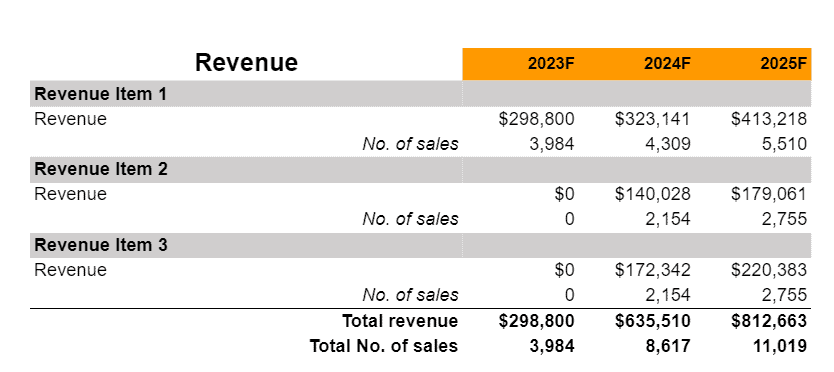
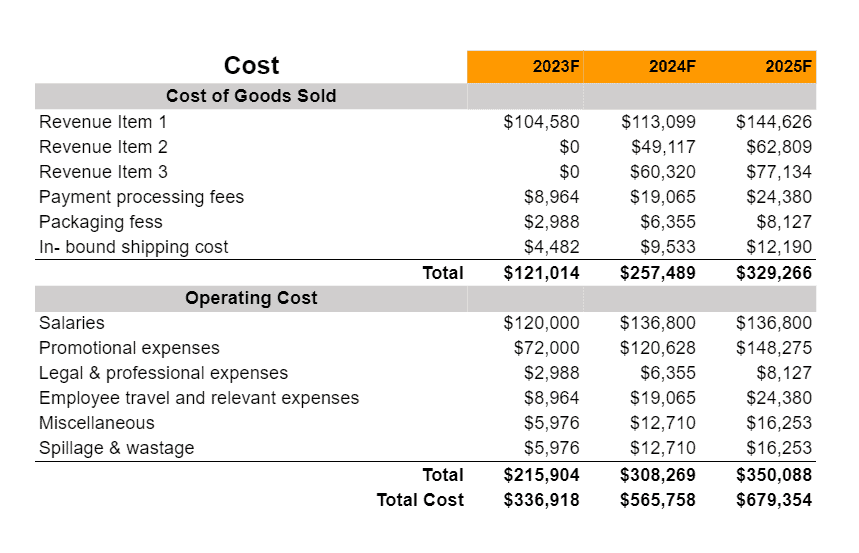
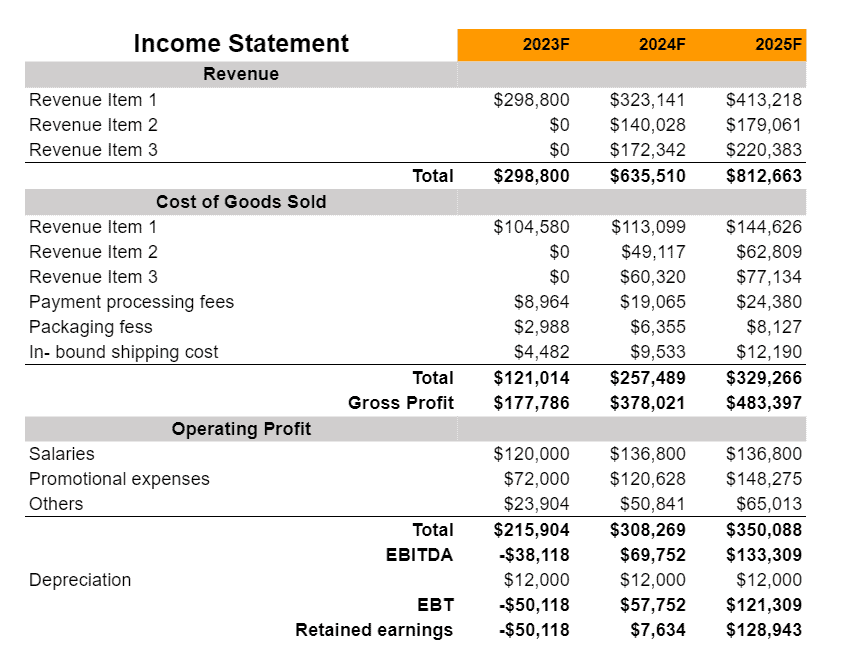
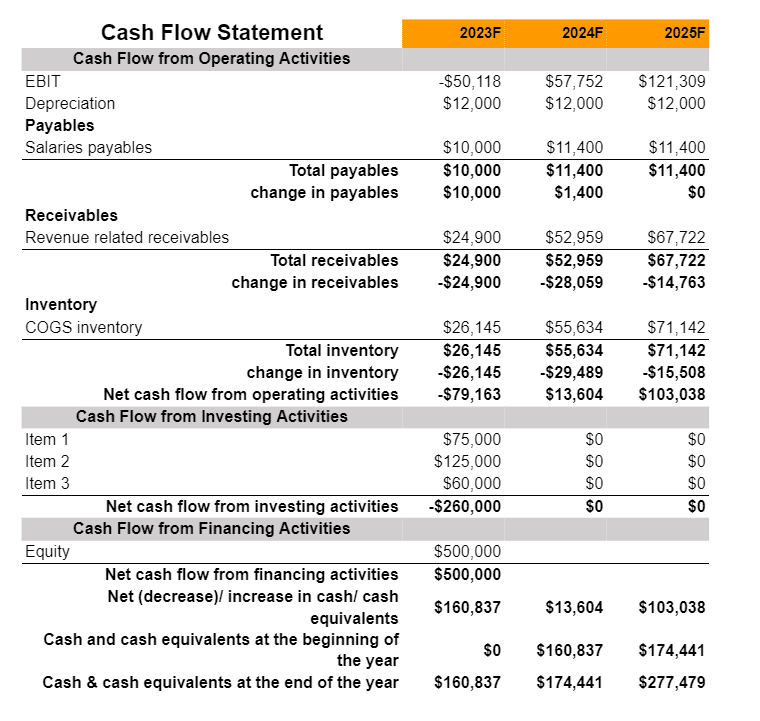
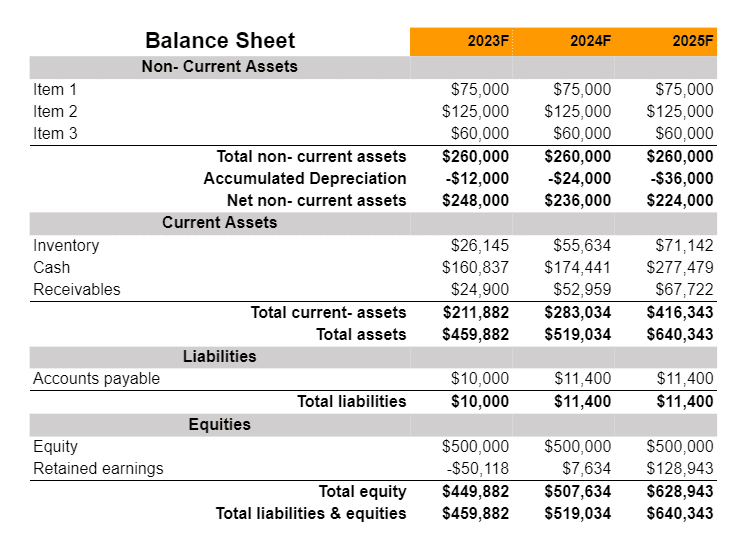
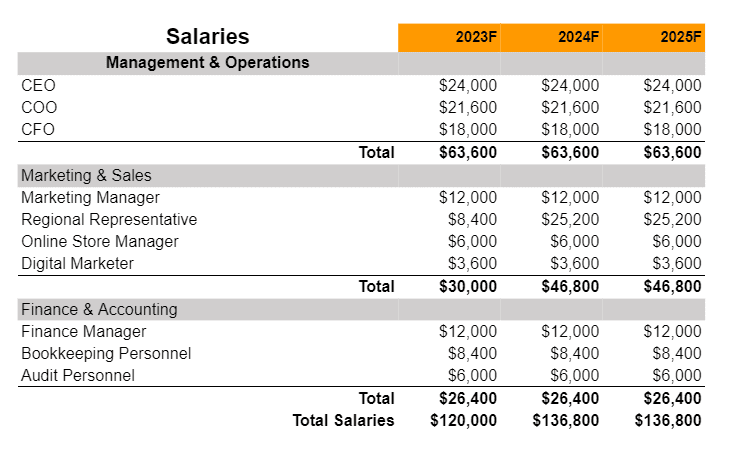
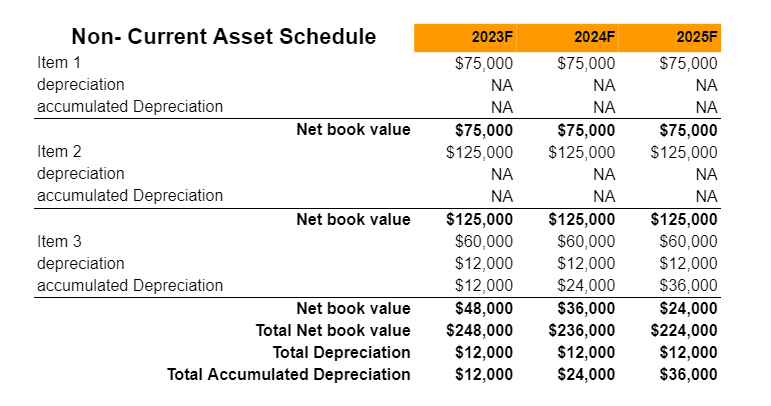
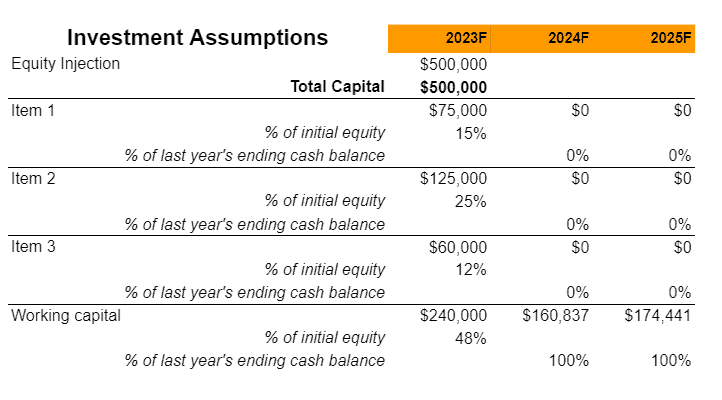
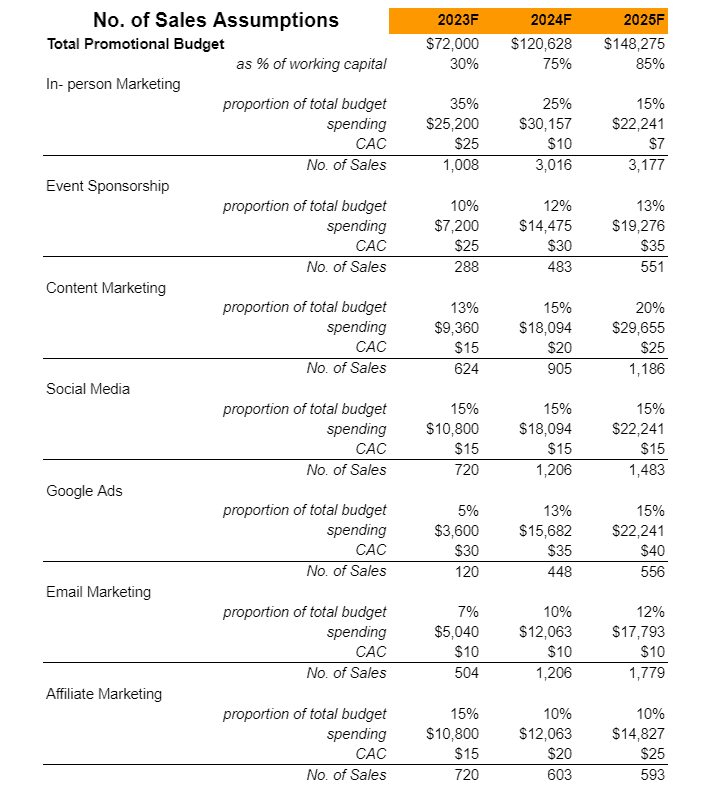
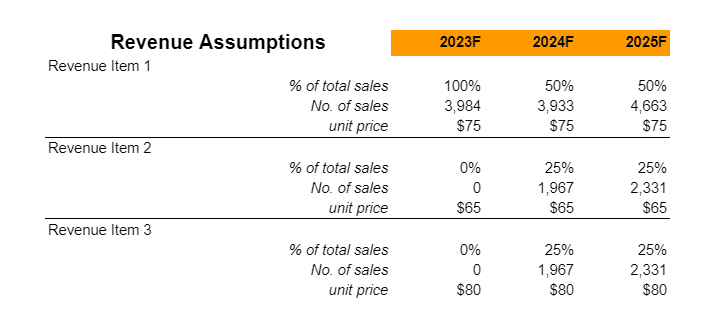
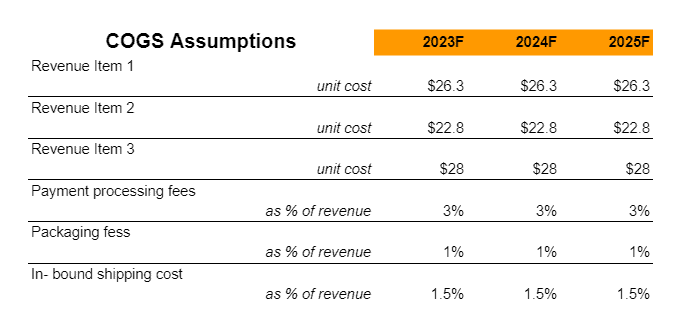
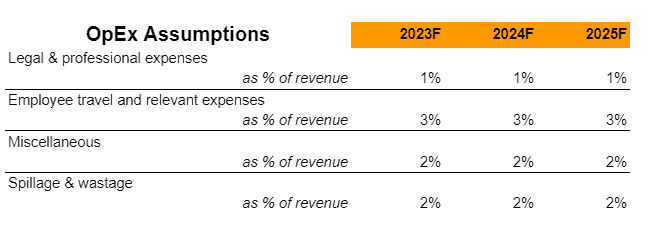
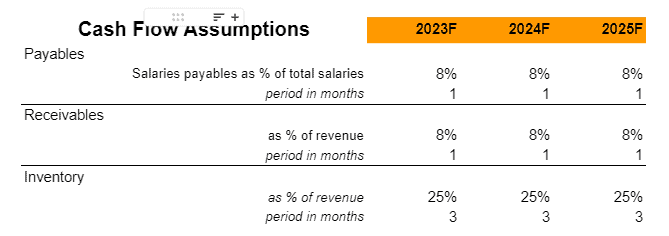
Related Articles

